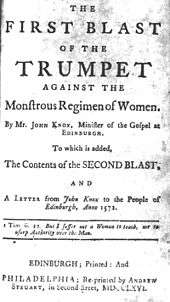The First Blast of the Trumpet Against the Monstruous Regiment of Women

The First Blast of the Trumpet Against the Monstruous Regiment of Women[1] is a polemical work by the Scottish reformer John Knox, published in 1558. It attacks female monarchs, arguing that rule by females is contrary to the Bible.
Title
The title employs certain words in spellings and senses that are now archaic. "Monstruous" (from Latin monstruosus) means "unnatural"; "regiment" (Latin regimentum or regimen) means "rule" or "government". The title is frequently found with the spelling slightly modernised, e.g. "monstrous regiment" or "monstrous regimen". It is clear however that the use of "regimen" meant "rule" and should not be confused with "regiment" as in a section of an armed force.
Content
The book was written anonymously from Geneva, Switzerland, against the female sovereigns of his day, particularly Mary of Guise, Dowager Queen of Scotland and regent to her daughter Mary, Queen of Scots, and Queen Mary I of England. Knox, a staunch Protestant Reformer, opposed the Catholic queens on religious grounds, and used them as examples to argue against female rule over men generally. Building on his premise that, according to Knox's understanding of the Bible, "God, by the order of his creation, has [deprived] woman of authority and dominion" and from history that "man has seen, proved, and pronounced just causes why it should be", he argued the following with regard to the specific role of women bearing authority:
For who can denie but it repugneth to nature, that the blind shal be appointed to leade and conduct such as do see? That the weake, the sicke, and impotent persones shall norishe and kepe the hole and strong, and finallie, that the foolishe, madde and phrenetike shal gouerne the discrete, and giue counsel to such as be sober of mind? And such be al women, compared vnto man in bearing of authoritie. For their sight in ciuile regiment, is but blindnes: their strength, weaknes: their counsel, foolishenes: and judgement, phrenesie, if it be rightlie considered.
His diatribe against female rulers had negative consequences for him when Elizabeth I succeeded her half-sister Mary I as Queen of England; Elizabeth was a supporter of the Protestant cause, but took offence at Knox's words about female sovereigns. Her opposition to him personally became an obstacle to Knox's direct involvement with the Protestant cause in England after 1559.
See also
Notes
- ↑ The title actually appears in all capitals, except for the last three words; in accordance with 16th-century orthographical norms, capitalized "trumpet" and "monstruous" are written TRVMPET and MONSTRVOVS.
Further reading
- Lee, Patricia-Ann (1990). "A Bodye Politique to Governe: Aylnter, Knox and the Debate on Queenship". The Historian. 52 (2): 242. doi:10.1111/j.1540-6563.1990.tb00780.x.
- Healey, Robert M.; et al. (1994). "Waiting for Deborah: John Knox and Four Ruling Queens". The Sixteenth Century Journal. 25 (2): 371–386. doi:10.2307/2542887. JSTOR 2542887.
- Fitzsimmons, Tracy (2000). "A Monstrous Regiment of Women? State, Regime, and Women's Political Organizing in Latin America". Latin American Research Review. 35 (2): 216–229. JSTOR 2692141.
- Brammall, Kathryn M. (1996). "Monstrous Metamorphosis: Nature, Morality, and the Rhetoric of Monstrosity in Tudor England". The Sixteenth Century Journal. 27 (1): 3–21. doi:10.2307/2544266. JSTOR 2544266.
- Richards, Judith M. (1997). "'To Promote a Woman to Beare Rule': Talking of Queens in Mid-Tudor England". The Sixteenth Century Journal. 28 (1): 101–121. doi:10.2307/2543225. JSTOR 2543225.
- Felch, Susan M. (1995). "The Rhetoric of Biblical Authority: John Knox and the Question of Women". The Sixteenth Century Journal. 26 (4): 805–822. doi:10.2307/2543787. JSTOR 2543787.
- Kyle, Richard G. (1988). "The Church-State Patterns in the Thought of John Knox". Journal of Church and State. 30 (1): 71–87. doi:10.1093/jcs/30.1.71.
External links
- The First Blast of the Trumpet Against the Monstrous Regiment of Women by John Knox
- eTexts of The First Blast, at Project Gutenberg